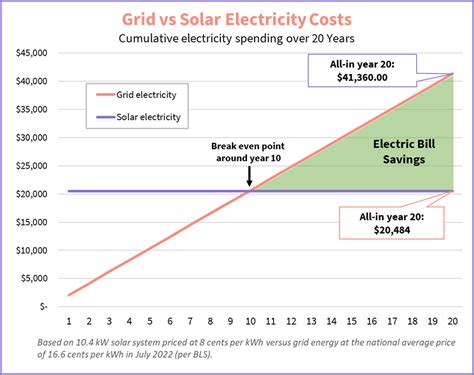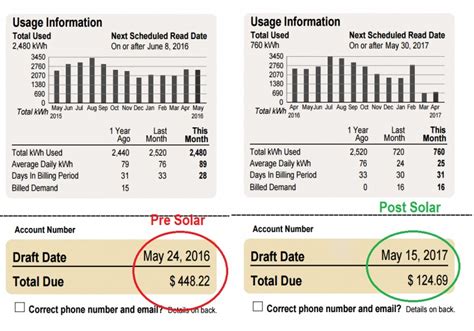
A California homeowner who invested in solar panels five years ago is now facing unexpectedly high energy bills, prompting a reevaluation of the long-term cost savings and benefits of residential solar energy systems. The homeowner’s experience highlights potential hidden costs and complexities associated with solar panel ownership, including grid connection fees, usage charges, and the impact of net energy metering (NEM) policies.
Solar Dream Turns Sour: Homeowner’s High Energy Bill Raises Questions About Solar Savings
For many homeowners, installing solar panels represents a significant investment toward energy independence and lower utility bills. However, one California resident’s experience is serving as a cautionary tale, revealing that the promise of solar savings isn’t always guaranteed. After five years of owning a solar panel system, the homeowner, identified as JJ, was shocked to receive an unexpectedly high energy bill, leading them to question the true cost-effectiveness of their investment.
JJ shared their experience on a popular online forum, explaining how their energy bill remained substantial despite having solar panels. “I’m still getting charged an arm and a leg,” JJ wrote, detailing the breakdown of their bill, which included grid connection fees, usage charges, and other unexpected costs. This revelation has sparked a widespread discussion among solar panel owners and prospective buyers, raising critical questions about the long-term financial benefits of solar energy systems and the complexities of navigating utility company policies.
The experience underscores the importance of thoroughly understanding all associated costs and potential limitations before investing in solar panels. While solar energy can significantly reduce reliance on traditional energy sources, homeowners must carefully consider factors such as their energy consumption habits, local utility rates, and the intricacies of net energy metering programs to accurately assess the potential return on investment.
The Breakdown: Understanding the Unexpected Costs
Several factors contributed to JJ’s unexpectedly high energy bill. One significant element was the grid connection fee, a charge imposed by the utility company for maintaining access to the electrical grid. Even with solar panels generating electricity, homes typically remain connected to the grid to supplement their energy needs during periods of low sunlight or high demand. This connection ensures a continuous power supply, but it also comes with associated costs.
Another factor was usage charges, which are based on the amount of electricity consumed from the grid. While solar panels can offset a significant portion of a home’s energy consumption, they may not completely eliminate the need for grid electricity, particularly during peak hours or periods of heavy usage. In JJ’s case, these usage charges contributed significantly to their overall bill.
The intricacies of net energy metering (NEM) also played a crucial role. NEM is a billing mechanism that allows solar panel owners to receive credit for excess electricity they send back to the grid. However, the value of these credits can vary depending on the utility company’s policies and the time of day the electricity is generated. In some cases, the credits may not fully offset the cost of electricity drawn from the grid, leading to a net charge for energy consumption.
JJ’s experience highlights the importance of understanding the specific terms and conditions of the NEM agreement with the local utility company. Factors such as the rate at which excess electricity is credited, the timing of those credits, and any limitations on the amount of credit that can be accumulated can significantly impact the overall savings from solar panels.
Net Energy Metering (NEM) Policies: A Complex Landscape
Net Energy Metering (NEM) policies are designed to incentivize the adoption of solar energy by allowing homeowners to receive credit for the excess electricity their solar panels send back to the grid. However, these policies vary significantly from state to state and even among different utility companies within the same state. Understanding the specific NEM rules in your area is crucial for accurately assessing the potential financial benefits of solar panel ownership.
In California, NEM policies have undergone several revisions over the years. NEM 1.0 and NEM 2.0 were previous iterations that offered relatively favorable terms for solar panel owners. However, the current policy, known as NEM 3.0 or Net Billing Tariff (NBT), has introduced significant changes that have impacted the economics of residential solar.
Under NEM 3.0, the value of exported solar energy is tied to a “Avoided Cost Calculator” (ACC) that is specific to each utility. The ACC changes hourly and monthly. This means that the compensation rate for excess solar energy is typically lower than the retail rate for electricity consumed from the grid. This change has reduced the financial incentive for solar panel owners to export excess energy to the grid and has made it more important to consume as much solar energy as possible on-site.
Furthermore, NEM 3.0 introduces new grid participation charges and interconnection fees, which can add to the overall cost of solar panel ownership. These charges are intended to help cover the costs of maintaining the grid and integrating distributed energy resources like solar panels.
The transition to NEM 3.0 has sparked considerable debate, with proponents arguing that it is necessary to ensure a fair and sustainable grid while opponents claim that it undermines the economics of solar and discourages adoption. Understanding the specific provisions of NEM 3.0 in California, or the equivalent NEM policy in your state, is essential for making an informed decision about investing in solar panels.
Beyond the Initial Cost: Considering the Long-Term Factors
When evaluating the potential savings from solar panels, it’s essential to consider factors beyond the initial cost of the system and the projected energy production. These long-term factors can significantly impact the overall financial benefits of solar panel ownership.
One crucial factor is the degradation rate of the solar panels. Over time, solar panels gradually lose their efficiency, producing less electricity than when they were new. The typical degradation rate for most solar panels is around 0.5% per year, meaning that a panel that initially produces 300 watts of power may only produce 285 watts after ten years. This degradation can reduce the amount of electricity generated by the system and impact the overall savings.
Another factor to consider is maintenance costs. While solar panels are generally low-maintenance, they may require occasional cleaning to remove dirt and debris that can reduce their efficiency. Additionally, components such as inverters may need to be replaced during the lifespan of the system. These maintenance costs should be factored into the overall financial analysis.
The lifespan of the solar panels is also an important consideration. Most solar panels come with a 25-year warranty, but their actual lifespan may be longer or shorter depending on the quality of the panels and the environmental conditions in which they are installed. When calculating the long-term savings from solar panels, it’s essential to estimate the lifespan of the system and account for any potential replacement costs.
The Importance of Energy Audits and Consumption Habits
Before investing in solar panels, it’s highly recommended to conduct an energy audit of your home to identify areas where you can reduce your energy consumption. By improving your home’s energy efficiency, you can reduce the size of the solar panel system needed and maximize the savings from solar energy.
An energy audit can help you identify air leaks, insulation deficiencies, and inefficient appliances that are contributing to high energy bills. By addressing these issues, you can lower your overall energy consumption and reduce your reliance on both grid electricity and solar energy.
Additionally, it’s essential to understand your energy consumption habits and how they align with the availability of solar energy. For example, if you consume most of your electricity during the evening hours when the sun is not shining, you may need to rely more on grid electricity, even with solar panels. By shifting your energy consumption to coincide with solar production, you can maximize the benefits of your solar panel system.
Consider using smart home devices to automate energy consumption. Smart thermostats, for instance, can adjust the temperature based on occupancy and time of day, reducing energy waste. Smart plugs can turn off appliances when they are not in use, and energy monitoring systems can provide detailed insights into your energy consumption patterns.
Financing Options and Incentives: Navigating the Solar Landscape
The cost of installing solar panels can be a significant barrier for many homeowners. However, various financing options and incentives are available to help make solar energy more accessible.
One popular financing option is a solar loan, which allows you to borrow money to pay for the cost of the solar panel system. Solar loans typically have fixed interest rates and repayment terms, making it easier to budget for the monthly payments.
Another option is a solar lease, which allows you to lease the solar panel system from a third-party company. With a solar lease, you don’t own the system, but you benefit from the electricity it generates. Solar leases typically have lower upfront costs than solar loans, but you may not be eligible for the same tax credits and incentives.
A Power Purchase Agreement (PPA) is another financing option that allows you to purchase the electricity generated by the solar panel system at a fixed rate. With a PPA, you don’t own the system, but you benefit from the lower electricity rates.
In addition to financing options, various tax credits and incentives are available to help reduce the cost of solar panels. The federal government offers an Investment Tax Credit (ITC) that allows you to deduct a percentage of the cost of the solar panel system from your federal taxes. Many states and local governments also offer additional tax credits, rebates, and grants for solar energy.
The Environmental Benefits of Solar Energy
Beyond the potential financial benefits, solar energy offers significant environmental advantages. Solar energy is a clean and renewable energy source that does not produce greenhouse gas emissions or air pollution. By reducing your reliance on fossil fuels, you can help mitigate climate change and improve air quality.
Solar energy also reduces the demand for water resources. Traditional power plants often require large amounts of water for cooling, which can strain water supplies in arid regions. Solar energy does not require water for operation, making it a more sustainable energy source.
Furthermore, solar energy can help diversify the energy supply and reduce dependence on foreign energy sources. By generating electricity locally, solar energy can improve energy security and reduce the vulnerability of the energy grid to disruptions.
Expert Opinions and Industry Insights
Industry experts emphasize the importance of conducting thorough research and seeking professional advice before investing in solar panels. “It’s crucial to understand the specific terms and conditions of your net energy metering agreement and to factor in all associated costs, including grid connection fees and usage charges,” says a representative from the Solar Energy Industries Association (SEIA).
“Homeowners should also consider the long-term factors, such as the degradation rate of the solar panels and the potential for maintenance costs,” adds an energy consultant specializing in renewable energy. “An energy audit can help you identify ways to reduce your energy consumption and maximize the savings from solar energy.”
Experts also recommend obtaining multiple quotes from different solar installers to ensure that you are getting the best price and the most suitable system for your needs. “Don’t be afraid to ask questions and to negotiate the terms of the contract,” advises a consumer advocate specializing in solar energy.
FAQ: Frequently Asked Questions About Solar Energy and Energy Bills
- Why is my energy bill still high even after installing solar panels? Several factors can contribute to high energy bills despite having solar panels, including grid connection fees, usage charges for electricity drawn from the grid, the terms of your net energy metering (NEM) agreement, and your overall energy consumption habits. You may still need to draw electricity from the grid during periods of low sunlight or high energy demand, and NEM policies may not fully offset these costs.
- What is net energy metering (NEM) and how does it work? Net energy metering (NEM) is a billing mechanism that allows solar panel owners to receive credit for excess electricity they send back to the grid. The value of these credits can vary depending on the utility company’s policies and the time of day the electricity is generated. NEM policies differ by state and utility company, so it’s important to understand the specific rules in your area.
- How can I reduce my energy consumption and maximize the savings from solar panels? To reduce your energy consumption, conduct an energy audit of your home to identify areas where you can improve energy efficiency, such as air leaks, insulation deficiencies, and inefficient appliances. Shift your energy consumption to coincide with solar production, and consider using smart home devices to automate energy consumption.
- What financing options and incentives are available for solar panels? Various financing options are available for solar panels, including solar loans, solar leases, and power purchase agreements (PPAs). The federal government offers an Investment Tax Credit (ITC) that allows you to deduct a percentage of the cost of the solar panel system from your federal taxes. Many states and local governments also offer additional tax credits, rebates, and grants for solar energy.
- What are the environmental benefits of solar energy? Solar energy is a clean and renewable energy source that does not produce greenhouse gas emissions or air pollution. It also reduces the demand for water resources and can help diversify the energy supply and reduce dependence on foreign energy sources. Solar energy contributes to mitigating climate change, improving air quality, and enhancing energy security.
Conclusion: Weighing the Pros and Cons of Solar Energy
JJ’s experience serves as a reminder that the decision to invest in solar panels requires careful consideration and thorough research. While solar energy offers numerous benefits, including reduced reliance on fossil fuels and potential cost savings, it’s essential to understand the potential limitations and hidden costs.
Before making a decision, homeowners should conduct an energy audit of their home, understand their energy consumption habits, and carefully evaluate the terms and conditions of their net energy metering agreement. It’s also crucial to obtain multiple quotes from different solar installers and to seek professional advice from energy consultants and consumer advocates.
By weighing the pros and cons of solar energy and taking the necessary steps to make an informed decision, homeowners can determine whether solar panels are the right investment for their needs and circumstances. The key is to approach the decision with realistic expectations and a thorough understanding of the complexities involved.
The push towards renewable energy sources continues, but stories like JJ’s underscore the need for transparency and comprehensive information for consumers venturing into the solar market. As policies and technologies evolve, staying informed is essential to ensure that solar investments deliver the promised benefits and contribute to a sustainable energy future. The experience serves as a critical lesson: that upfront research, understanding local utility policies, and realistic expectations are paramount to ensuring that the solar dream doesn’t turn into a financial burden. The need for continued education and advocacy remains crucial as more homeowners consider solar energy as a viable option.









